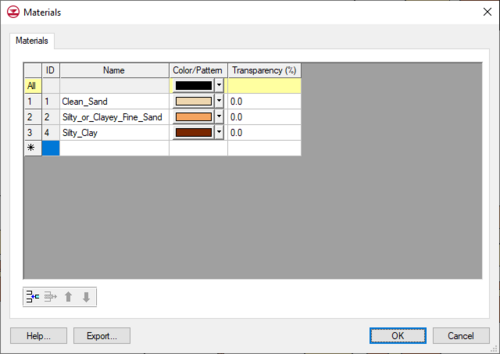User:Rcorrigan/Materials: Difference between revisions
(Created page with "Many of the objects in GMS (ex., elements, solids, borehole regions) have an associated material. Materials typically represent a type of soil or rock. A global list of materi...") |
No edit summary |
||
| (9 intermediate revisions by the same user not shown) | |||
| Line 1: | Line 1: | ||
__NOINDEX__ | |||
Many of the objects in GMS (ex., elements, solids, borehole regions) have an associated material. Materials typically represent a type of soil or rock. A global list of materials is maintained and can be edited using the '''Materials''' command in the ''Edit'' menu. | Many of the objects in GMS (ex., elements, solids, borehole regions) have an associated material. Materials typically represent a type of soil or rock. A global list of materials is maintained and can be edited using the '''Materials''' command in the ''Edit'' menu. | ||
==Materials Dialog== | ==Materials Dialog== | ||
[[Image:Material_Tools.png|thumb|92 px|Insert, delete, move up, move down buttons]] | [[Image:Material_Tools.png|thumb|92 px|Insert, delete, move up, move down buttons]] | ||
The Materials are listed in a spreadsheet. Materials have an ID, name, color | The Materials are listed in a spreadsheet. Materials have an ID, a name, and a color or pattern. New materials can be created by typing in the last row, or by copying and pasting from a spreadsheet, or by selecting the '''Insert''' button. The dialog also has tabs showing model specific properties for each [[GMS:Numerical Models|numerical model]] in use. The materials might have more properties depending on the model in use. | ||
:[[File:GMSMaterials.png|thumb|none|left|500 px|An example of the ''Materials'' dialog.]] | :[[File:GMSMaterials.png|thumb|none|left|500 px|An example of the ''Materials'' dialog.]] | ||
| Line 11: | Line 12: | ||
==Materials File== | ==Materials File== | ||
The material names, colors, patterns, and transparencies can be exported by selecting the '''Export''' button. This will save out a "material" file with a *.mat extension. This file can be imported into GMS using the ''File'' | '''Open''' command. | The material names, colors, patterns, and transparencies can be exported by selecting the '''Export...''' button. This will save out a "material" file with a *.mat extension. This file can be imported into GMS using the ''File'' | '''Open''' command. | ||
==Related Topics== | ==Related Topics== | ||
Latest revision as of 21:17, 16 March 2022
Many of the objects in GMS (ex., elements, solids, borehole regions) have an associated material. Materials typically represent a type of soil or rock. A global list of materials is maintained and can be edited using the Materials command in the Edit menu.
Materials Dialog
The Materials are listed in a spreadsheet. Materials have an ID, a name, and a color or pattern. New materials can be created by typing in the last row, or by copying and pasting from a spreadsheet, or by selecting the Insert button. The dialog also has tabs showing model specific properties for each numerical model in use. The materials might have more properties depending on the model in use.
Materials Legend
A legend showing all the materials can be displayed in the Graphics Window. The legend can be turned on and off in the Display Options dialog.
Materials File
The material names, colors, patterns, and transparencies can be exported by selecting the Export... button. This will save out a "material" file with a *.mat extension. This file can be imported into GMS using the File | Open command.
Related Topics
GMS – Groundwater Modeling System | ||
|---|---|---|
| Modules: | 2D Grid • 2D Mesh • 2D Scatter Point • 3D Grid • 3D Mesh • 3D Scatter Point • Boreholes • GIS • Map • Solid • TINs • UGrids | |
| Models: | FEFLOW • FEMWATER • HydroGeoSphere • MODAEM • MODFLOW • MODPATH • mod-PATH3DU • MT3DMS • MT3D-USGS • PEST • PHT3D • RT3D • SEAM3D • SEAWAT • SEEP2D • T-PROGS • ZONEBUDGET | |
| Aquaveo | ||
